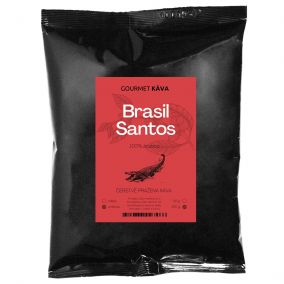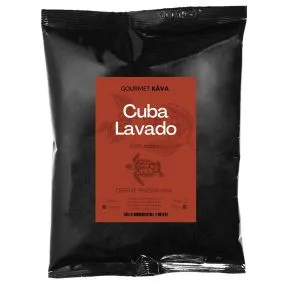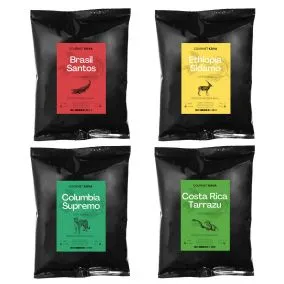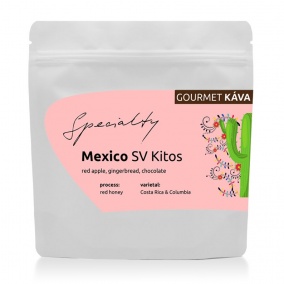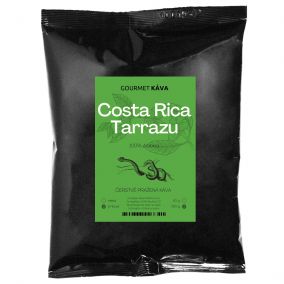Have you decided to indulge in a quality coffee that creates an atmosphere of well-being with its aroma and that you really enjoy? Then you may be faced with a relatively wide range of coffee beans and have no idea what to choose. Try it with us, pretty step by step...
-
It is good to know how coffee beans are distinguished
-
On the packaging of coffee you will find a number of data that are worth understanding so that you can choose the right raw material for your favorite drink. Coffee can be distinguished mainly on the basis of:
-
Varieties of coffee – or type of coffee plant< /a>.
-
Stage roasting – experts recognize many of them, we will briefly introduce the three basic ones:
-
Light – the lightest coffee exposed to the mildest degree of roasting, i.e. roasted for a shorter time, so that the oils remain inside the coffee bean - because they have not been exposed to such a high temperature that they start to release. Coffee roasted in this way has a high degree of acidity, which decreases with roasting time. The taste of this coffee did not have such a chance to develop, the aroma is rather fruity.
-
Medium – medium degree of roasting, the coffee beans have already been exposed to higher temperatures for a longer time, but the hidden oils inside have not yet been released. However, the taste tends to be richer, more balanced, sweeter and less sour.
-
Dark – now the coffee beans have been roasted long enough to release their oils, resulting in shiny, dark beans (lower roasts leave the beans dull in color), the original taste of coffee is suppressed, the flavor influenced by roasting comes to the fore. This coffee is therefore sweeter, very rich in taste, with low acidity.
In order to get a basic overview, this simplified presentation will suffice. Otherwise, of course, you can search and read up to about the twelve degrees of coffee roasting. In any case, the influence of taste and smell is also clear from the previous lines.
-
Do you know what you like?
-
-
It's time to think about which flavor of coffee is closest to you. Accordingly, you choose the variety, possibly a mixture of varieties and also the degree of roasting. In general, if you prefer naturally sweeter coffee with a mild acidity, you should reach for Arabica. Its taste is described by many as fruity, even floral, with hints of nuts and chocolate. In contrast, Robusta, Excelsa or Liberica stand out with a rather bitter-sweet, earthy taste.
You then need to add a suitable degree of roasting to the variety in order to get the perfect combination for you.
-
Differences in caffeine content
-
-
It is not only the taste and aroma that distinguish the individual varieties of the coffee plant from each other. The caffeine content of coffee beans varies depending on the type of coffee. Excelsa contains the least caffeine (about 1 gram per 100 g of coffee beans), followed by Liberica with 1.23 g per 100 g, then Arabica – 1.61 g/100 g and finally Robusta, whose caffeine content jumps up to 2.26 g in 100 grams of grains.
-
Check the roasting date
-
-
On the product label, you should pay enough attention to the date of roasting, not only to its degree. It is not good to consume coffee immediately after roasting, nor for a long time afterwards. It is best to hit the time between 4 days and 1 month after roasting. After roasting, carbon dioxide is released from the coffee. It does not affect the taste of the drink in any way, but it disrupts the heat treatment of the grains, or adequate extraction of ground coffee.
The process of releasing this substance from roasted coffee is faster with a higher degree of roasting (we recommend waiting 4-5 days), while it is desirable to wait 5-10 days for light roasted coffee.
Correctly stored coffee will of course retain its taste and aroma for more than a month, but at inappropriate temperatures, exposed to light and access to oxygen, its quality will suffer.
-
Coffee for taste and health
-
-
Arabica is repeatedly referred to as the healthiest (i.e. with the highest proportion of health-promoting substances). However, it is necessary to emphasize the fact that other types of coffee have not been tested to such an extent. Even after roasting, Arabica retains a high proportion of valuable substances and in this respect appears to be better than Robusta. However, it does not have such a caffeine content, which is related to the ability to increase energy levels, increase fphysical performance, etc. We must also mention that the highest degrees of roasting are capable of destroying a large amount of antioxidants, so if you take coffee as a healthy drink, you should take this fact into account when choosing.
Now you will undoubtedly be more confident in front of the coffee shelf. You can also ask an experienced salesperson in a number of specialized stores. In our e-shop, the individual products are clearly and clearly marked, there is also a comprehensible description that allows you to choose will definitely make it easier.
Brazil Santos, Arabica coffee beans
In stockBrazil is the world leader in the production and export of extremely high quality coffee beans. The best known and most popular is the 100 Brazil Santos.
Price €6.90Brazil is the world leader in the production and export of extremely high quality coffee beans. The best known and most popular is the 100 Brazil Santos.
Cuba Lavado, arabica coffee beans
In stockLavado coffee from the mountains of south-eastern Cuba will surprise you almost zero acidity and a distinctive taste of dark chocolate and caramel.
Price €7.90Lavado coffee from the mountains of south-eastern Cuba will surprise you almost zero acidity and a distinctive taste of dark chocolate and caramel.
Arabica from all over the world - 1kg, bargain...
In stockDo you know what coffee varieties 100 rabica to choose? Buy this mix of 4 different packs of 250g and save 50 CZK! Total 1kg of roasted coffee.
Regular price €28.35 -9% Price €25.90Do you know what coffee varieties 100 rabica to choose? Buy this mix of 4 different packs of 250g and save 50 CZK! Total 1kg of roasted coffee.
GourmetCoffee Specialty - Mexico SV Kitos 250g
Not in stockExcellent sweet roasted coffee for everyday drinking. Flavour profile: red cherry and mango with dark chocolate and cream
Price €12.90Excellent sweet roasted coffee for everyday drinking. Flavour profile: red cherry and mango with dark chocolate and cream
Costa Rica Tarrazu, arabica coffee beans
In stockTarrazu is a very fine and incredibly perfectly balanced coffee of high quality from the extinct volcanic mountains of Costa Rica.
Price €7.90Tarrazu is a very fine and incredibly perfectly balanced coffee of high quality from the extinct volcanic mountains of Costa Rica.



























































































